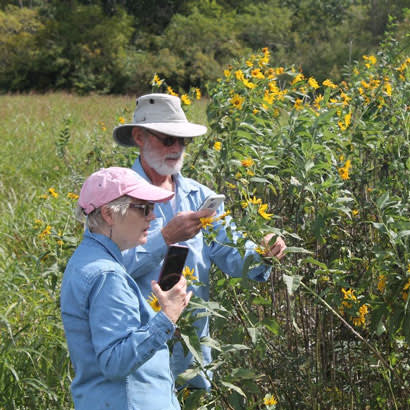
Is your department actively working on pollinator conservation practices? Do you have a means of documenting your current pollinators and plants species found on your park properties? Do you have a means of actively engaging your park users to help you with all these questions? These are all looming questions for one of the biggest conservation priorities we have today — pollinator conservation. The Dallas Park and Recreation Department has used community scientist driven BioBlitz events to help tackle these issues, and April — as well as throughout the summer — is a great time to plan pollinator based BioBlitz events.
These community science events are fun, easy to put on and very cost-effective for the information you get in return. We utilize smart phone technology with the iNaturalist app. Volunteers simply need to put the app on their phone and sign up with an email address. Then it is a simple matter of asking them to walk around and record observations of any plant and/or insect they see. Even young kids can do this — and kids provide a huge advantage. Kids will record things that adults may discount as being mundane. “Can I record this?” Encourage them to do so, because they may find something unique, like an invasive species you didn’t know you have.
It is nice to have several professional or volunteer naturalists around, but not a requirement. iNaturalist now has technology like facial recognition. If you get a decent photo, it is pretty good at guessing species. But then the magic of iNaturalist happens — people from all over the world start checking and verifying species identification. For a typical BioBlitz, I will wait about a week to 10 days to let the identification process play out. Depending on the scope of the BioBlitz event, you may have several hundred to several thousand observations.
So now, what do you do with that data? That is going to depend on your management objectives.
iNaturalist gives you a couple different means of analyzing the data. You can do a web-based query of specific species or a suite of species. After a BioBlitz event, I often like to look through the data for invasive species. Many times, I am simply trying to highlight the diversity of plants, animals and insects that can be found in a particular park (or in the whole city). iNaturalist now has BioBlitz and umbrella style “projects.” This allows you to have multiple properties/projects managed under one main project yet be able to break out specific parks as needed. If you end up with a large amount of data, iNaturalist gives you the ability to filter as you like on the website and download the data into an Excel file.
Let’s look at an example of iNaturalist data and a few visual aids that you can then use when talking to citizens, park staff and elected officials. In October 2018, we held a pollinator centric BioBlitz event at Harry S. Moss Park in Dallas. This event had 51 participants that we broke down in to 18 teams. We will sometimes break down into teams to accommodate for the technologically slow participants, better phones, like physical condition, and also for more nature interpretive efforts, especially with kids.

Between the 18 phones used, the community scientists were able to collect 354 observations in roughly one hour. Note, at this time I have not refined the data beyond specifying a date. But what if I want to only show verified, research grade plants? That is incredibly easy to do. I go to the filters and hit “verifiable,” “research grade,” and a leaf/plant symbol. Keep in mind, this is community scientists doing this in one hour.

What if I wanted to highlight the insects? Filter for insects. If I wanted to, I could filter for a single species, or all the butterflies and moths, or all the bees. How you sort the data is only limited by your imagination and your management objectives.

Once you have the data, what can you do with it? The easiest use is creating visuals, like the screen captures above, to highlight the overall diversity you have in the city. This is an incredibly import tool for building public support from citizens and elected officials for your conservation work. One of the basic tenants of natural resource management is having an inventory of your natural resources. When we started our prairie restoration efforts, we needed a baseline inventory of what species we already had in place. A BioBlitz is a great way to get that baseline inventory. The first two years, volunteers were encouraged to record anything and everything they saw. This provides a simple presence and absence of species. Now three years into the program, we have started to change the survey techniques a bit to get actual populations densities. With that information we can track the effectiveness of our assorted management techniques. Lastly, I use the data to look for emerging invasive species. I monitor assorted invasive species websites for emerging invasive species, then go work through the BioBlitz data looking for them appearing in Dallas.
BioBlitz events are fun for the citizens of your city and can provide you with valuable data. The data is most usable when you have defined your objectives ahead of time, and I would caution against planning on heavy duty statistics unless you have very strict procedures in place. But if you are looking for simple presence and absence, this is an awesome way to get the data. Spring is here and summer is just around the corner — the plants are greening up, in insects are getting active, it’s time to get outdoors and start collecting data. For more information, feel free to email me.
Brett Johnson is the Sr. Environmental Coordinator/Urban Biologist for Dallas Park and Recreation Department.

